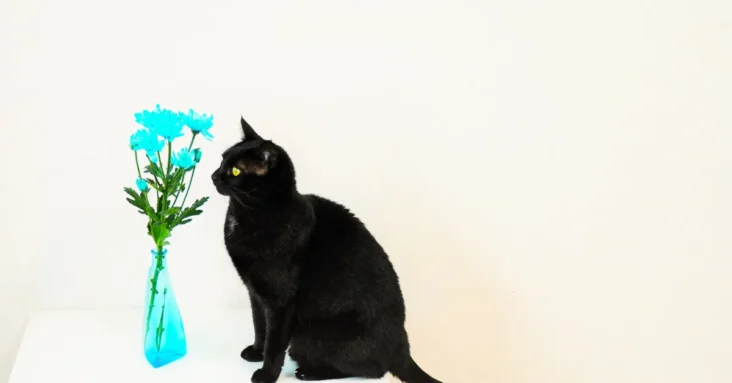Chrysanthemums are some of the most popular flowers out there. You see them everywhere—porches in fall, bouquets from the grocery store, even in backyard gardens. Their colors are stunning, and they last quite a while. But if you share your home with a cat, that vase of cheerful mums might raise a serious question: Are chrysanthemums toxic to cats?
The answer, unfortunately, is yes. But how dangerous are they? What should you do if your cat gets into them? And are there safer alternatives?
You’re not alone if you’ve ever felt torn between a beautiful plant and your cat’s safety. Let’s talk about what makes mums risky—and how to decorate without worrying every time your cat jumps on the table.
What Exactly Are Chrysanthemums?
First things first—chrysanthemums (often called “mums”) are flowering plants in many varieties and colors. From deep burgundy to soft yellow, they brighten up any space. They’re part of the Asteraceae family and are widely loved for their long-lasting blooms.
You’ll find them in pots, bouquets, and floral arrangements all year round, especially in autumn. They’re festive, affordable, and everywhere.
And that’s why knowing whether they’re safe for your cat is so important.
So… Are Chrysanthemums Toxic to Cats?
Yes, chrysanthemums are toxic to cats. The plant contains a group of natural chemicals called pyrethrins, which are used in some insecticides. While those compounds may not affect humans much, they can cause real trouble for a curious cat who decides to take a nibble.
Every part of the plant is potentially dangerous—leaves, stems, petals, even the pollen. While mums may not be as toxic as lilies (extremely deadly), they’re still nothing to mess around with.
What Happens If a Cat Eats a Chrysanthemum?
It depends on how much your cat ingests and how sensitive they are. Some cats might only chew a little and feel mildly sick. Others could experience more serious symptoms.
Common Symptoms Include:
- Drooling or foaming at the mouth
- Vomiting
- Diarrhea
- Loss of coordination (wobbly walking)
- Skin irritation if they brush against the plant
If your cat has eaten part of a chrysanthemum or shows any of these signs, don’t wait—call your vet. They may ask you how much was eaten, when it happened, and whether your cat is showing any symptoms.
I remember a friend calling in a panic because her cat had knocked over a fall-themed flower pot and started munching on a few leaves. It turned out to be chrysanthemums. Thankfully, her vet guided her through the process and, after a few uncomfortable hours, her kitty was wonderful. But it could have been worse.
How Quickly Do Symptoms Appear?
Usually within a few hours, but sometimes sooner. It depends on the cat. Some show signs right away, especially if they’ve chewed a lot. Others might seem fine at first, then start vomiting or staggering later in the day.
Cats are masters at hiding discomfort, so don’t assume they’re okay just because they’re quiet.
And remember—cats don’t need to eat a whole plant to get sick. Even licking the pollen off their paws or fur can cause problems, especially for indoor cats more sensitive to toxins.
Are Some Chrysanthemum Varieties Worse Than Others?
All chrysanthemums should be considered toxic to cats, regardless of the variety. Some cultivars may have higher concentrations of pyrethrins. Still, unless you’re a botanist, it’s not worth trying to figure out which ones are “less bad.”
The safest approach? Keep all mums out of your cat’s reach or your home entirely.
Can Touching a Chrysanthemum Hurt a Cat?
Yes, sometimes. Pyrethrins can cause skin irritation if your cat rubs against the plant, especially around their nose, ears, or belly. If your cat starts scratching or licking one spot after brushing against a mum, rinse the area gently and keep a close eye on them.
If the irritation doesn’t go away—or if they start acting “off”—it’s time for a vet visit.
What Should You Do If Your Cat Eats a Chrysanthemum?
Don’t panic—but act quickly.
Steps to Take:
- Remove the plant or any leftovers from your cat’s mouth or paws.
- Call your vet or an emergency animal poison hotline.
- Watch for symptoms like vomiting, drooling, or staggering.
- If possible, bring a piece of the plant or a photo to the vet so they know what your cat ingested.
Most cats recover just fine if treated quickly, but timing matters.
Are Chrysanthemums Dangerous to Dogs Too?
Yes, they are. Chrysanthemums are toxic to dogs and cats, so if you have a multi-pet household, it’s best to keep mums off your decorating list. Dogs might be less agile than cats when climbing onto countertops, but they’re not immune to curiosity.
Safer Alternatives to Chrysanthemums
If you love decorating with flowers but want to keep your feline friend safe, there are plenty of beautiful, non-toxic options.
Cat-Safe Flowers:
- Roses (without pesticides)
- Snapdragons
- Marigolds
- Zinnias
- African violets
- Orchids
- Sunflowers
You can also consider faux chrysanthemums. Some look incredibly realistic and give the same cozy fall vibe—without the risk.
I’ve switched to a mix of sunflowers and artificial mums during autumn, and honestly, no one can tell the difference. My cats? They barely glance at them.
Why Cats and Plants Don’t Always Mix
Cats are naturally curious. Leaves move, petals smell interesting, and stems seem like perfect chew toys. But many houseplants and flowers carry hidden risks.
Even if your cat doesn’t typically eat plants, one moment of boredom or a new environment can be all it takes.
Decorating with pet-safe flowers doesn’t mean sacrificing style. It just means being thoughtful and choosing safety over impulse buys.
A Pretty Flower Isn’t Worth the Risk
Chrysanthemums may be beautiful, but they don’t belong in a cat-friendly home. While they’re not the most deadly flowers out there, the risk isn’t worth it, especially when there are so many gorgeous, safe alternatives.
If you genuinely love your cats—and I know you do—let the mums stay at the store. Your cat might not say thank you, but they’ll show it quietly, cuddly.
Because nothing says “home” like a place where your pets can be curious, comfortable, and completely safe.






GIPHY App Key not set. Please check settings